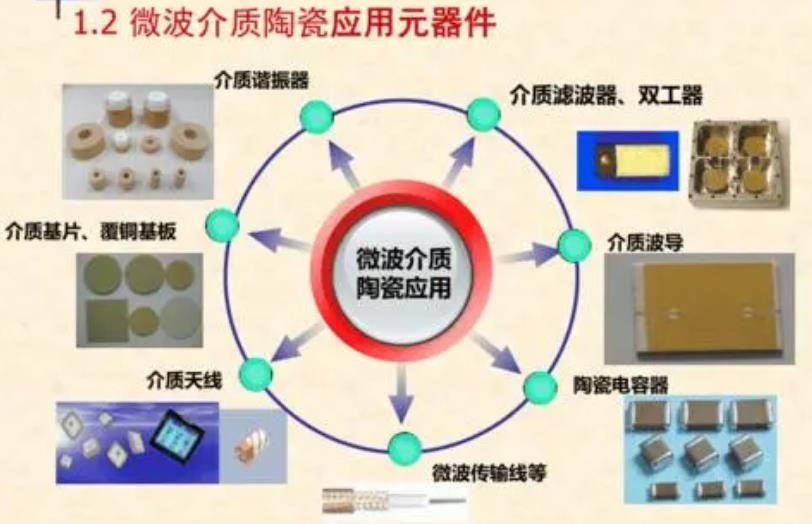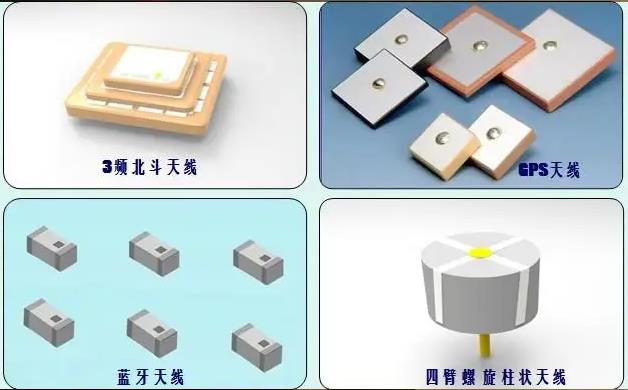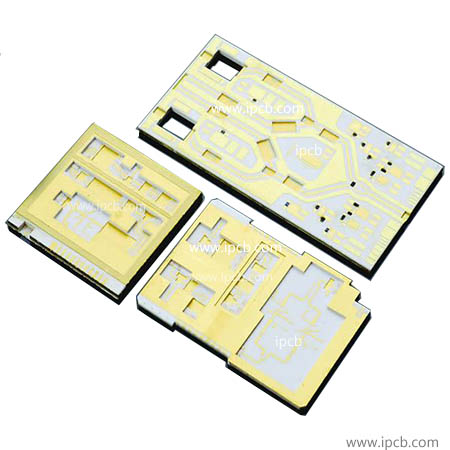1、Microwave dielectric LTCC ceramics Performance parameters and significance
The parameters that characterize the performance of microwave dielectric ceramics are the dielectric constant (ε)
The product of quality factor and resonant frequency (Q × f), r
The temperature coefficient of resonant frequency (τ). f

The dielectric constant is the name of the dielectric polarization ability, the stronger the dielectric polarization ability, the higher the dielectric constant. The polarization channels in inorganic dielectrics include electron displacement polarization, ion displacement polarization, electron relaxation polarization, ion relaxation polarization and space charge polarization, and -15-12-13-2-9 spontaneous polarization also exists in ferroelectric data. In this order, the polarization build-up times are 10s, 10-10s, 10-10s, -2-510-10s, and from a few seconds to tens of hours. In the microwave frequency band (frequency greater than 300MHz), the microwave signal electric field square - 9 direction of the transition time is almost all less than 10s, the polarization establishment time of several kinds of polarization pipeline can not keep up with the rhythm of the electric field changes, the contribution to the dielectric constant can not play a role, only the electronic displacement polarization and ion displacement polarization on the dielectric constant of the dielectric contribution. Compared to the ion displacement polarization, electronic displacement polarization of the dielectric constant contribution is very small, so the microwave dielectric ceramic dielectric constant is mainly determined by the ion displacement polarization.
Quality factor (Q) is a microwave dielectric system energy dissipation metrics, but Q is with the resonant frequency or component volume changes and changes, and in the microwave frequency range, the quality factor and resonant frequency product Q × f is a fixed value.
The temperature coefficient of resonance frequency (τ) represents the characteristic of the data resonance frequency change with temperature, which reflects the stability of microwave dielectric ceramic f components.
2. LTCC microwave dielectric ceramics classification
LTCC ceramic materials can be categorized according to their functions: LTCC substrate and packaging data, LTCC microwave components data.
LTCC substrate and packaging materials are mainly divided into three categories: glass and ceramic composite systems, microcrystalline glass systems, glassless ceramic systems. Glass and ceramic composite system of glass for low dielectric constant, low softening point of glass, in the sintering process to play a role in aiding the dissolution of the sintering process, it is related to the sintering temperature and shrinkage rate of the substrate, but also so that the substrate has a low dielectric constant. The insulation resistance of the glass phase should be high, the chemical stability should be good, and the softening point should not be too low. The ceramic filler phase is a low dielectric constant, high thermal conductivity component. In the sintering process on the substrate to play the role of skeleton and support, it gives the substrate a certain mechanical strength and insulation, can prevent sintering glass softening caused by the substrate warpage and other deformation. These ceramic filler phases are mainly Al2O3, SiO2, cordierite and mullite. Microcrystalline glass is made from silicate glass or pensilicate glass by forming crystals in the glass seed after heat treatment at a certain temperature regime. Microcrystalline glass in the size of the grain and the percentage content of the crystalline phase is very important, grain smile and high percentage of microcrystalline glass mechanical strength, high-frequency loss is small. Suitable nucleation time is favorable to obtain sufficient nucleation concentration, so as to obtain higher crystal phase content and small grains. The crystal growth temperature and holding time are also important. The proper heat treatment regime is one of the keys to determining the data performance. The main microcrystalline glass systems are cordierite (2MgO?2AlO?5SiO), sillimanite232 (CaO?SiO), lithium pyroxene (LiO?AlO?4SiO), and calcium feldspar (CaO?AlO?2SiO). The glassless ceramic systems of 22232232 do not contain glass phases that lead to high losses and often have good microwave dielectric performance. The simple composition of the systems adds to the stability and reliability of the data in the preparation process.
In addition to good microwave dielectric performance to meet the needs of different functions, LTCC microwave components data should be sintered at a temperature below 950 ℃, and sintered without reacting with Ag, the powder should be easy to cast. At present, LTCC microwave components data is mainly on the existing microwave dielectric ceramic materials sintered at reduced temperature. As the LTCC technology becomes more and more extensive, the development of new LTCC microwave component data has become a research hot spot. The research is developing in multiple directions, on the one hand, in order to improve the performance of the device to develop high-quality factor data system, at the same time, in order to adapt to the trend of wireless communication and network to continue to develop in the direction of high-frequency and broadband, the development of ultra-low dielectric loss and ultra-low permittivity of the LTCC microwave component data has become an important development trend.

3. LTCC microwave dielectric ceramics research progress
LTCC microwave dielectric ceramic materials are used to make LTCC microwave components, LTCC microwave components mainly include LTCC dielectric substrates, LTCC antennas, waveguides, resonators, and LTCC capacitors and their combination devices. Among them, LTCC microwave resonator is the most important and basic application, based on the LTCC microwave resonator can make a series of components, such as LTCC microwave filters, duplexers, oscillators, and balanced a unbalanced converter. LTCC microwave resonators require the appropriate dielectric constant of the ceramic dielectric data, generally 20~60, so as to ensure a high quality factor (Q) user in the case of high dielectric constant of the data, reducing the size of the component. Ceramic resonant frequency temperature coefficient should be small. Ceramic sintering temperature should be lower than 950°C. Ceramic powders are easy to cast and do not react with Ag electrodes during sintering.
Conventional microwave dielectric ceramic materials have excellent microwave dielectric performance, but their intrinsic sintering temperature is high, generally above 1300? Common low-temperature sintered microwave dielectric ceramic materials include Ca[(LiNb)Ti]O, BiNbO4, 1/32/31-xx3- δ ZnTiO, ZnNbO, and LiO-NbO-TiO, etc., whose intrinsic sintering temperatures are in the range of 950~1200? These ceramic materials cannot meet the sintering temperature requirements of LTCC. In order to be suitable for LTCC technology and co-firing with Ag, Cu and other metal conductors in air, the sintering temperature of the above microwave dielectric ceramic material systems needs to be further reduced to below 950? Microwave dielectric ceramics sintered at around 900? can be obtained by the following ways: (1) adding low melting point glass or oxides (e.g., CuO, VO, BiO, BO, ZnO, etc.) to conventional microwave dielectric ceramics; (2) synthesizing microwave dielectric ceramics by wet chemical method. (3) Searching for new microwave dielectric ceramics with low sintering temperature.
LTCC low-temperature co-firing microwave dielectric ceramics research is mainly through the following two ways: one is to select the inherent sintering temperature is higher, but the phase composition is simple, the phase structure is stable, the microwave dielectric performance is excellent microwave dielectric ceramic materials as a substrate, add more low melting point of the glass sintered at low temperatures of about 900 ¡æ and still maintain a considerable dielectric performance; a selection of the intrinsic sintering temperature is low and good dielectric performance of microwave ceramic materials as a substrate, add less glass phase or low melting point of the oxide can be realized in about 900 ¡æ low temperature sintering. One is to choose microwave dielectric ceramics with inherently low sintering temperature and good microwave dielectric performance as the substrate, and to add less glass phase or low melting point oxides to realize low-temperature sintering at about 900? The addition of sintering aids (low melting point glass or oxides) often causes deterioration of the microwave dielectric performance of the data, and the amount of sintering aids should be reduced in the composition of the ceramics, so the development of a new system of microwave dielectric ceramics with an intrinsically low sintering temperature is of practical and important significance. New environmentally friendly low-temperature co-fired microwave dielectric ceramic filter data systems can be used in multiphase composites, and may also be generated in several low-temperature oxides obtained from the combination of compounds. The development of low-loss glasses and the synthesis of sintering aids using wet chemistry are both worthwhile research directions.
To learn more about LTCC (Low Temperature Co-Fired Ceramics) products, please click: LTCC (Low Temperature Co-Fired Ceramics) Circuit Boards.
